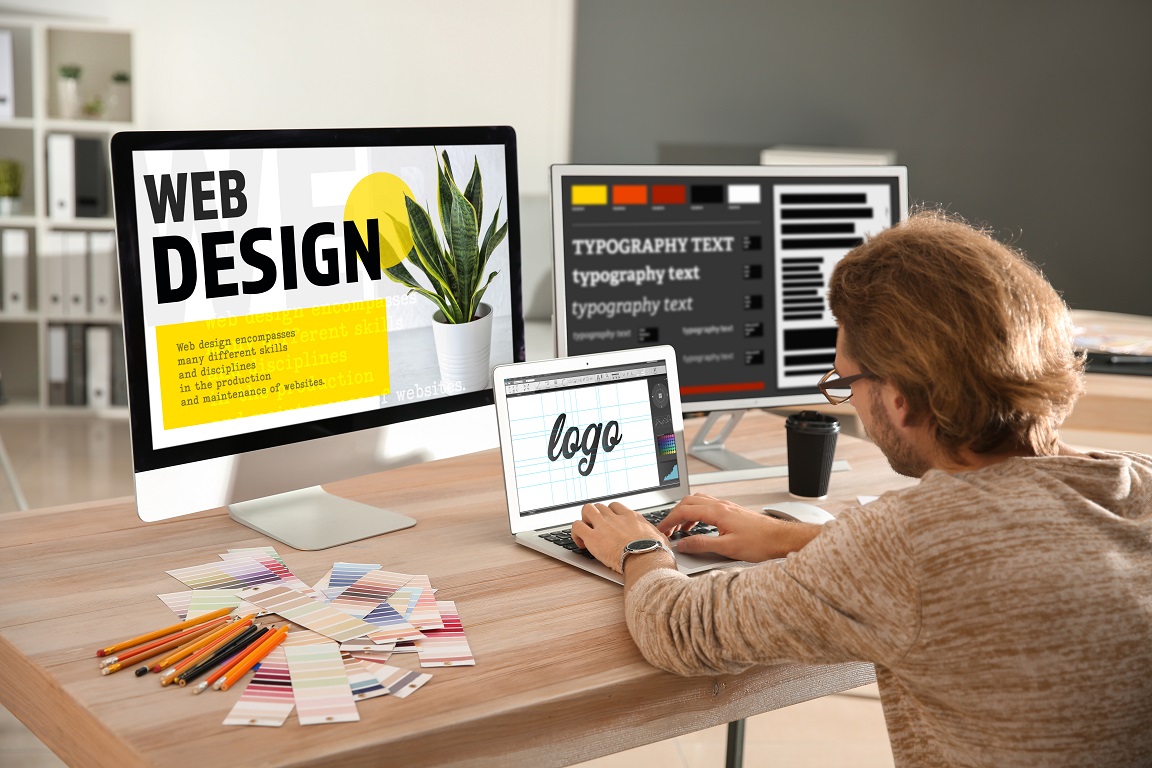Leading Web Design services that assist businesses build stronger online brands
Wiki Article
The Importance of User Experience in Efficient Web Design Strategies
User experience (UX) works as a foundation in reliable web design approaches. It shapes exactly how customers interact with a website, influencing their contentment and chance of returning. A properly designed UX can enhance interaction via instinctive navigation and receptive designs. Nonetheless, overlooking these facets may lead to stress and boosted bounce rates. Recognizing the intricacies of UX is necessary for designers intending to develop compelling electronic experiences that reverberate with diverse audiences. What elements genuinely drive effective user involvement?Comprehending User Experience and Its Influence On Layout
Although user experience (UX) is typically regarded as a simple element of web design, it fundamentally shapes just how users connect with a site. UX includes all elements of the user's communication, including functionality, access, and overall complete satisfaction. A positive UX cultivates engagement, encouraging users to explore the site and return in the future. Conversely, a negative experience can bring about stress, leading to high bounce rates and lost chances for conversion.Style components like navigating, layout, and web content company play vital roles fit this experience. Reliable UX design anticipates user requirements and preferences, making certain that information is conveniently accessible and aesthetically enticing. Furthermore, recognizing user habits through analytics can supply useful insights, informing layout decisions that enhance functionality. Eventually, a comprehensive understanding of UX enables developers to produce web sites that not just attract individuals however likewise promote meaningful communications that line up with service objectives and user expectations.
Secret Principles of Effective User Experience
Efficient user experience pivots on several crucial concepts that boost internet site functionality and interaction. Intuitive navigating style, responsive format basics, and the value of visual hierarchy are vital components that add to a seamless interaction in between individuals and web material. Comprehending these principles allows developers to create even more straightforward and accessible electronic atmospheres.User-friendly Navigating Layout
User-friendly navigating style offers as a vital portal to their general experience when customers experience a web site. Efficient navigation allows customers to easily situate the details they look for, enhancing their interaction with the website. Secret principles include clear labeling, logical organization, and regular placement of navigating elements. Labels must be uncomplicated, allowing customers to anticipate the material they will certainly discover. A well-structured pecking order aids customers recognize the connection between various sections, guiding them through the website flawlessly. In addition, responsive food selections and easily obtainable web links add to a fluid experience throughout devices. By focusing on instinctive navigating, designers can significantly reduce user disappointment and increase engagement, ultimately cultivating a positive understanding of the website and its web content.Receptive Design Basics
A well-structured navigation system normally brings about the need for a responsive format, which is important in today's diverse electronic landscape. A responsive layout warranties that websites feature seamlessly throughout different devices, including tablet computers, desktop computers, and mobile phones. This adaptability improves user experience by allowing content to be visually coherent and easily accessible, regardless of display size. Secret principles of receptive style consist of fluid grids, adaptable photos, and media queries, which assist in perfect watching. Furthermore, focusing on touch-friendly aspects enhances interaction on mobile devices. By applying a responsive format, developers can accommodate users' needs, reduce bounce prices, and boost interaction. Ultimately, a well-executed responsive layout cultivates a positive user experience, urging visitors to discover the web site further.Visual Pecking Order Significance
Aesthetic power structure plays a crucial role in directing individuals via an internet site, making sure that essential details captures their interest first. By strategically utilizing dimension, comparison, spacing, and shade, developers can develop a clear pathway for customers to comply with. Bigger components commonly draw the eye, showing their relevance, while contrasting colors can highlight contact us to action. Additionally, constant positioning and group of associated content boost comprehension, making navigation instinctive. Efficient use of aesthetic hierarchy not just boosts functionality yet also sustains the general aesthetic of the site, fostering a favorable user experience. When users can easily determine the most critical details, they are extra most likely to engage with the content, leading to boosted contentment and interaction with the website.The Duty of Functionality in Web Design
Usability plays a necessary function in web design, particularly via navigation simplicity and adherence to availability criteria. Reliable navigation boosts user fulfillment by permitting visitors to locate information quickly and without effort. Meeting availability criteria ensures that all users, regardless of their capabilities, can effectively communicate with the website.Navigating Simplicity
Simplicity in navigation stands as a cornerstone of reliable web design, substantially affecting user experience. A streamlined navigation system permits customers to discover info swiftly and intuitively, lowering stress and enhancing contentment. Clear labeling and rational structure are crucial elements, directing individuals effortlessly via the website. Repetitive web links or excessively complex food selections can disorient individuals, resulting in raised bounce prices. Furthermore, mobile responsiveness should be thought about, guaranteeing navigating stays uncomplicated throughout devices. Focusing on essential web pages and decreasing clutter additionally supports user engagement. Effective navigation not only fosters a favorable experience but likewise urges users to check out the site a lot more completely, ultimately resulting in greater conversion prices. In this regard, navigating simplicity acts as an important aspect in the total performance of web design strategies.Accessibility Requirements
User engagement is greatly boosted when sites stick to access criteria, guaranteeing that all individuals, no matter of their capabilities, can browse and connect successfully. Conformity with these criteria not just widens the audience but likewise boosts total user complete satisfaction. Accessible style includes functions such as message choices for images, keyboard navigation, and adequate color comparison, which assist in usage by people with handicaps. On top of that, executing these criteria can favorably impact search engine optimization (SEARCH ENGINE OPTIMIZATION) by enhancing site structure and quality. As web design evolves, focusing on availability comes to be necessary in cultivating an inclusive electronic environment. By accepting these criteria, developers add to a more equitable web, ultimately driving user loyalty and involvement.Relevance of Responsive Style for User Interaction
As customers progressively accessibility sites with a selection of tools, the value of receptive design comes to be critical for engaging users visit our website effectively. Receptive layout guarantees that a site adapts effortlessly to various screen sizes, offering a perfect viewing experience despite the tool utilized. This adaptability improves user interaction by promoting simpler navigating and interaction with material.When users encounter an internet site that is receptive, they are more probable to remain longer, explore better, and return in the future. A well-designed responsive format lessens the frustration usually associated with zooming and scrolling on smaller displays, thereby minimizing bounce prices. Additionally, receptive design can favorably influence search engine positions, as internet search engine focus on mobile-friendly internet sites. In today's digital landscape, where mobile usage continues to climb, carrying out receptive design is not just beneficial, yet crucial for keeping user engagement and assuring a favorable experience throughout all devices.
Enhancing Load Times for Better User Satisfaction

To improve tons times, internet developers should focus on optimizing pictures, leveraging internet browser caching, and lessening HTTP requests. Additionally, using Content Distribution Networks (CDNs) can speed up material delivery by dispersing it across various geographic places. Enhancing code, such as pressing CSS and JavaScript files, even more contributes to quicker filling speeds.
Inevitably, a dedication to improving tons times not just boosts user satisfaction however also reinforces brand commitment and improves the possibility of repeat brows through. A swift, seamless experience is important for maintaining customers and fostering positive communications.
The Impact of Visual Pecking Order on User Interaction
Aesthetic pecking order functions as a necessary component in assisting user communication on an internet site. By arranging content in a manner click here for more that prioritizes info aesthetically, developers can influence how users browse and engage with a website. This power structure is developed with various style strategies, consisting of dimension, spacing, contrast, and shade. Larger fonts or vibrant shades attract attention to critical aspects, such as telephone calls to action or headlines, while restrained shades and smaller fonts can indicate subservient info.Effective aesthetic power structure aids users quickly recognize what is crucial, lowering cognitive tons and enhancing functionality. It permits intuitive navigation, making it easier for individuals to find what they require without stress. As customers communicate with an internet site, a well-structured visual pecking order cultivates an extra satisfying experience, ultimately leading to higher engagement and conversion prices. Designers need to prioritize these principles to produce an user-centered and efficient internet setting.
Gauging User Experience: Methods and tools

Regularly Asked Concerns
Just How Can I Enhance My Web site's User Experience on a Spending plan?
To boost a website's user experience on a spending plan, one can optimize web page lots speed, streamline navigating, execute receptive style, improve content quality, and collect user responses for continuous improvements, ensuring a satisfying visitor experience.What Are Usual User Experience Mistakes to Prevent in Web Design?
Typical user experience blunders in web design consist of cluttered layouts, inadequate navigating, slow filling times, lack of mobile responsiveness, ignoring accessibility, irregular branding, and failing to focus on user feedback - Web Design Agency. Each can greatly impede general website effectiveness
Exactly how Typically Should I Update My Internet Site for Better User Experience?
Internet sites must be upgraded frequently, ideally every couple of months, to preserve excellent user experience. Frequent updates aid address functionality issues, revitalize web content, and adapt to transforming user needs, ensuring the website continues to be interesting and relevant.
Can User Experience Impact SEO Rankings on My Website?
User experience can substantially affect SEO positions, as internet search engine prioritize internet sites that supply seamless link navigation, fast packing times, and engaging web content. A positive user experience can bring about lower bounce rates and higher search presence.What Role Does Access Play in User Experience Layout?
Accessibility plays an important function in user experience design by making certain that all people, regardless of capacities, can browse and interact with a web site properly. This inclusivity boosts total satisfaction and interaction amongst varied customers.User experience (UX) is usually perceived as a mere facet of internet design, it essentially shapes exactly how individuals communicate with a web site. User interaction is considerably enhanced when web sites stick to access requirements, guaranteeing that all individuals, no matter of their abilities, can navigate and engage effectively. Gauging user experience (UX) is necessary for recognizing how efficiently a site meets the needs of its users. In addition, usability screening, where real individuals navigate the website while onlookers note difficulties, uses direct comments on user experience. Usual user experience blunders in internet style consist of messy layouts, poor navigating, slow-moving filling times, lack of mobile responsiveness, disregarding access, inconsistent branding, and failing to prioritize user comments.
Report this wiki page